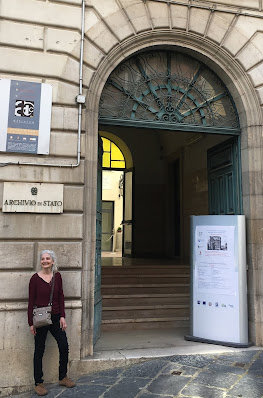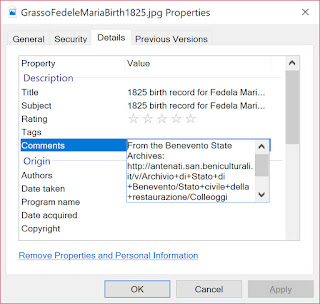Growing up, I knew my grandfathers had come to America from Italy as young men. When I started researching my family history, I found their immigration records on the Ellis Island website.
According to their ship manifests, each of my grandfathers were joining a relative who'd already made the voyage.
Have you found a ship manifest for any of your ancestors? Are you squeezing every bit of information out of that page or two?
If so, you know each passenger names someone they left at home, and someone who's waiting for them at their destination. The amount of detail depends on the year of immigration. If your ancestor came through Ellis Island, you'll find lots of information.
 |
| A ship manifest holds lots of details about your ancestor. |
Where Were They From, Where Were They Going?
When my Grandpa Pietro Iamarino arrived in New York City on 29 November 1920, he was leaving his "Father Iamarino" in "Collo Samino, Ben." First of all, thank goodness I knew his father's name was Francesco or I'd be mighty disappointed. Second of all, "Collo Samino, Ben." is a typewritten misspelling of Colle Sannita, with "Ben." being short for the province of Benevento. Again, thank goodness I knew the town name already.
Grandpa arrived with $11 in his pocket to join his "Uncle Pilla Di Gennaro" at 22 West Street, Newton, Massachusetts. This lead was a dead end to me for quite a while. Over time, after I'd learned more about Grandpa's family, I realized something. The "Di Gennaro" part of that description meant that his uncle was the son of Gennaro Pilla—my grandfather's grandfather.
So Grandpa was joining his mother's brother, Antonio Pilla, in Massachusetts.
Follow the Leader
So what do you do next? You look for Antonio's ship manifest. Was he the first in the family to come to America, or was there someone before him?
Antonio Pilla, my second great uncle, left Italy for Philadelphia seven years earlier in 1913. The ship manifest says he left his father Gennaro in Colle Sannita, Italy. He was travelling with his brother-in-law. Both men were joining Antonio's brother Innocenzo Pilla in Lawsonham, Pennsylvania, to work in the mine or for the railroad.
Another link in the chain! Next I searched for my other second great uncle, Innocenzo Pilla. He sailed to Boston in 1909 with two of his brothers-in-law. One of them was my great grandfather, Francesco Iamarino.
The group was going to the Bronx, New York, to join my other second great uncle, Francesco's brother, Giuseppe Iamarino.
I can't seem to find Giuseppe's ship manifest, but he's in the 1905 New York State Census living in the Bronx. His seven-year-old son was born in Italy, so the family must have arrived between 1898 and 1905.
My uncle Giuseppe may have been the first in that branch to come to America. That led to his two brothers and one brother-in-law following him in 1909. And that lead to my uncle Antonio joining his brother Innocenzo in 1913. And that led to my grandfather Pietro joining his uncle Antonio in 1920.
A Migration Pattern
 |
| In May 2018 I visited the memorial to fallen soldiers in my grandfather's hometown of Colle Sannita, Italy. |
My great grandfather Francesco didn't stay in America. But I've found ship manifests for him in 1903, 1909, 1913, and 1929. He came to join his brother Giuseppe the first three times. He stayed and worked for the railroad for a while, then went home to his wife and daughters in Italy.
On his final trip in 1929 he visited his son Pietro, my grandfather, in Youngstown, Ohio. He may have worked for the railroad for a while. Or maybe he came to meet his son's wife and baby daughter.
It's All Part of Your Heritage
Follow the path of the relative or friend your ancestor joined when they immigrated. You may unwind a series of sea voyages and a bunch more relatives.
Thank goodness our ancestors had the strength to make such a difficult journey—sometimes over and over. You've got to admire what they did to survive. You've got to admire their courage.
Be proud of your ancestors. And keep honoring them by documenting their lives.














